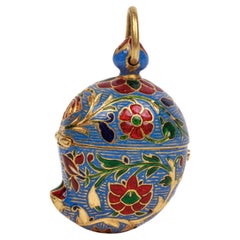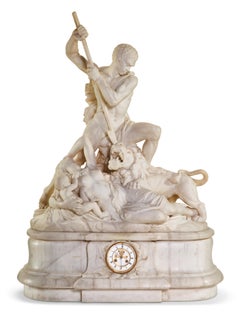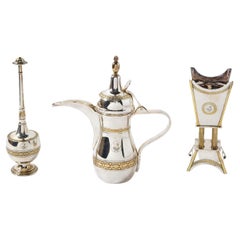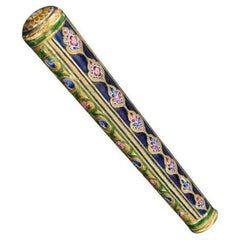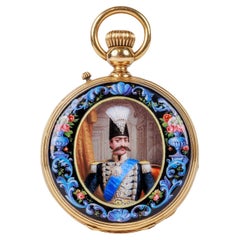Solomon Treasure
Antique 19th Century Indian Pendant Necklaces
Gold, Enamel
19th Century Figurative Sculptures
Marble
20th Century British Enamel Frames and Objects
Silver
Antique 19th Century Unknown Enamel Frames and Objects
Gold, Enamel
19th Century Animal Paintings
Oil, Board
Antique 19th Century Swiss Pocket Watches
Enamel, Gold
19th Century Romantic Figurative Paintings
Oil
Antique 19th Century Swiss Pocket Watches
Gold, Enamel
19th Century Academic Figurative Sculptures
Bronze
Antique 18th Century Indian Boxes and Cases
Rock Crystal, Gold
19th Century Romantic Portrait Paintings
Oil
20th Century French Art Deco Figurines and Sculptures
Agate, Diamond, Emerald, Rock Crystal, Gold, Silver
19th Century Portrait Paintings
Oil
20th Century Indian Anglo-Indian Boxes and Cases
Diamond, 22k Gold, Enamel
20th Century Italian Art Deco Vanity Items
Diamond, Rock Crystal, Silver
20th Century Landscape Paintings
Oil
20th Century French Figurines and Sculptures
Amethyst, Diamond, Jade, Quartz, Rock Crystal, Ruby, Turquoise, Gold, Si...
Late 19th Century Art Nouveau Figurative Paintings
Canvas, Oil
Antique Early 19th Century American More Objets d'Art and Vertu
Gold
Mid-19th Century Landscape Paintings
Oil
20th Century Chinese More Objets d'Art and Vertu
Coral, Diamond, Onyx, 18k Gold
19th Century Baroque Figurative Sculptures
Alabaster
20th Century Figurines and Sculptures
Agate, Rock Crystal, 14k Gold
20th Century German Figurines and Sculptures
Diamond, Labradorite, 18k Gold, Enamel
19th Century Portrait Paintings
Canvas, Oil
21st Century and Contemporary French Figurines and Sculptures
Diamond, Lapis Lazuli, Rock Crystal, Gold, Silver
21st Century and Contemporary French Frames
Coral, Lapis Lazuli, Silver
20th Century Italian Figurines and Sculptures
Amethyst, Diamond, Tourmaline, Jasper, 18k Gold
20th Century Italian Figurines and Sculptures
Coral, Diamond, Emerald, Moonstone, Pearl, Ruby, Blue Sapphire, 14k Gold
Antique 19th Century American Sterling Silver
Sterling Silver, Copper
Antique 16th Century Dutch Renaissance Busts
Oak
Early 20th Century Austrian Art Nouveau Desk Sets
Silver, Enamel
20th Century French Floor Lamps
Crystal
Antique 19th Century Austrian Greek Revival Urns
Ormolu
Antique 19th Century American American Classical Figurative Sculptures
Marble
Antique 19th Century French Collectible Jewelry
Gold, Enamel
Antique 19th Century Japanese Meiji Metalwork
Enamel
Antique 19th Century French Qing Ceramics
Coral, Silver
20th Century French Art Deco Snuff Boxes and Tobacco Boxes
Glass
Antique 19th Century French Napoleon III Busts
Malachite, Sterling Silver
Antique 19th Century Japanese Meiji Vases
Copper, Enamel
Antique 19th Century Meiji Vases
Silver
Antique 19th Century French Louis XVI Candelabras
Bronze, Ormolu
Antique 19th Century French Louis XVI Garniture
Bronze, Ormolu
Antique 19th Century French Napoleon III Table Lamps
Bronze, Ormolu
Vintage 1960s Japanese Sculptures and Carvings
Coral
Antique 19th Century German Vases
Porcelain
Antique 19th Century Japanese Meiji Furniture
Mother-of-Pearl, Wood, Lacquer
Antique 19th Century French Napoleon III Candelabras
Bronze, Enamel, Ormolu
20th Century Italian Animal Sculptures
Sterling Silver
Early 20th Century American Arts and Crafts Cigar Boxes and Humidors
Multi-gemstone, Bronze, Enamel
Antique 19th Century French Figurative Sculptures
Bronze
20th Century Islamic Animal Sculptures
Steel
Antique Early 19th Century Indian Anglo-Indian Furniture
Wood
Antique 19th Century French Japonisme Mantel Clocks
Enamel, Ormolu
Antique 19th Century French Japonisme Wall Lights and Sconces
Bronze
Antique 19th Century French Napoleon III Commodes and Chests of Drawers
Marble, Ormolu
Antique 19th Century British Victorian Centerpieces
Metal, Bronze
Antique 19th Century French Napoleon III Console Tables
Bronze, Ormolu
Antique Late 19th Century Chinese Tibetan Metalwork
Bronze
